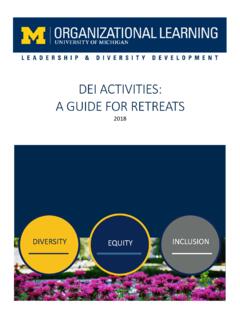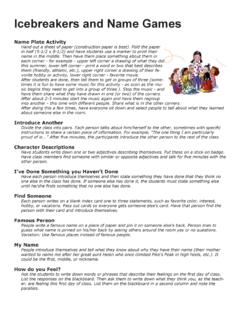Transcription of Sample Sports Program For Youth Ages 11-14
1 Sample Sports Program FOR Youth ages 11-14 As used by Anapa Christian Camp June 19-30, 1999 Program DESCRIPTION AND OVERVIEW This Program was designed to provide a combination of structured team competition and group free choice for younger children. The authors of the Program took into consideration the fact that this age group ( 11-14 ) is a challenge to motivate when it comes to an intense competition schedule (hence the ample free time), and that these children love fun group activities (thus the variety of unique team competitions each day). The camp (counsellors & campers) was split into four teams (16 groups = 4 on each team), with as much balance as possible (age, sex, number). Team competitions were held each morning (each team being involved in one 45-minute competition per morning). The remaining morning Sports time and all afternoon Sports periods were comprised of cabin group choice.
2 In order to make the competition more interesting, groups were given unique team names (Noah s Animals, David s Sheep, Samson s Body-Builders and Daniel s Lions) and were awarded points based on cheering & participation as well as for 1st, 2nd, 3rd and 4th place. Team scores were kept throughout the week and prizes were awarded on the last evening (candy, fruit, ice cream, etc with each team receiving something). Overall the Program was a success. Sports Schedule There were normally 5 Sports periods in a day. Two in the morning: at 1120-1210 and 1220-1310; two in the afternoon: at 1500-1600 and 1615-1715; and one in the evening: at 1815-1930. During the morning and afternoon periods there were crafts, music & drama options as well as sport choices. All options were chosen via a sign-up sheet filled in by the counsellor of each group (see form 1: Sport Sign-up Sheet).
3 The team competitions were announced via poster, with locations of events listed as well (see form 2: Competition Schedule). DAY ONE (SUNDAY) Note: This was arrival day; therefore there was no Sports Program in the morning or afternoon. 1815-1930 Opening icebreakers Note: In order to better familiarize the campers & counsellors with each other, several different large group icebreakers were played: Autograph game Everyone was given a piece of paper and a pencil and was told to gather as many different signatures as possible within a set time limit. Birth month The group was asked to get together with everyone who shares the same birth month as they. Eye colour The group was asked to get together with everyone who shares the same eye colour as they. Hairstyle The group was asked to get together with everyone who shares the hairstyle as they.
4 Skin colour The group was asked to get together with everyone who shares the same skin colour as they. DAY TWO (MONDAY) Note: An exception was made for the first full day of the camp Program . The crafts, drama and music programs were put on hold until the afternoon. This was done to allow all the campers to experience icebreakers and opening relays on the first day The goal for this day was to help the cabin groups formrelationships and the assist the counsellors in leading their campers in activities.. 1120-1220 icebreakers with counsellors in their cabin groups Note: Because most camps will not have more than a handful of sport instructors, this part of the Program will need to be pre-taught to the counsellors so that they may lead without assistance. Each Sports Instructor was assigned to one or two cabin groups.
5 Prepared with a list of activities and needed equipment, they helped the counsellors teach the following icebreakers from the CCI Sports manual (terms in brackets indicate the type of icebreaker): Toss-a-Name game (name-learning) Booop (comfort-creating) Finger Count (comfort-creating) Mirror Image (comfort-creating) Stand-Off (positive physical parameters) Toe Fencing (positive physical parameters) Suitcase (sharing) Posi-Ball (sharing) 1220-1310 Soccer Dribble Relay and Bat Twist Relay Relay tips: All instructions must be given clearly before starting the relay and a Sample run is a good visual explanation of what they are to do. Always remember that in a relay all teams should have the same number of people. If there is not an even number then have one of the teams with fewer peoplehave someone repeat rather than take some away from the other teams.
6 For these relays, the winning team was the one done first (shown by everyone sitting). :SOCCER DRIBBLE RELAY Type of Competition: Relay Preparation for Event: The group was divided into four teams, with all four teams lined up (face to back) behind a line (long rope) at one end of the field. At the opposite end of the field (about 50 metres away) was the second line (rope). A soccer ball (or similar all balls should be identical) is needed for each team. Instructions Given: The object of this relay is to kick/dribble the soccer ball from one line to the other and back as quickly as possible. The ball must completely cross the distant line before you begin kicking it back. Try to pass the ball to next person on the line, not just kick it across. Once the first person has returned the ball, the second does the same. However, he may only leave his position when the ball has crossed over the starting line.
7 You may only use your feet to contact the ball, hands are not allowed. Once the ball has been handed off , the person completing the task goes to the end of the line and sits or kneels down while the rest of the team remains standing. When everyone is finished there will be a line of sitting team members. BAT TWIST RELAY Note: For a camper under 14 years old 4 turns of the bat is best and for older campers 7 turns is recommended. This activity is meant to produce harmless dizziness, and is of negligible risk. It is a lot of fun and everyone can join in. Type of Competition: Relay Preparation for Event The four teams were kept, with the teams lined up behind the lines. A baseball bat (or similar object) is needed for each team. Instructions Given: At the whistle the first person in each line places their forehead on the bat, with the other end on the ground, and spins around slowly (X-number of times).
8 The group behind him should keep counting out loud to make sure he does it the right number of times. Once the correct number of turns has been done, the participant drops the bat and runs to the opposite line and back. Once he has returned across the line, the second person begins spinning. The person completing the task goes to the end of the line and sits or kneels down while the rest of the team remains standing. When everyone is finished there will be a line of sitting team members. 1815-1930 Individual Choice Sport instructors were assigned to a variety of locations to supervise (trampoline, archery, baseball) and the campers were given the opportunity to visit and participate in any sport activity they chose. DAY THREE (TUESDAY) Note: Starting this day, and continuing throughout the session, two different teams competed at 1120, while the other two teams had activities according to their signed-up choices.
9 At 1220 the two teams who competed did their signed-up activiies and the other two teams came for the competitiont. , rt. 1120-1220 and 1220-1310 Basketball Relay and T-Shirt Relay BASKETBALL RELAY Type of Competition: Relay Preparation for Event: A basketball court (with one basket at each end) and several basketballs (or similar rubber balls all should be alike) are needed. For each of the two baskets two shooting positions were marked. Divide each team into two and place each half team at one of the four shooting positions. Instructions Given: Each team lines up behind the line and each person takes turns trying to make a basket. The players shoot the ball and rebound their own shot taking or throw the ball to their next player in line. When a basket is made the whole team shouts the number. When 10 baskets are reached the team should cheer as the winners.
10 The first team on each court to score 10 baskets (points) will be the winner. After each basket has a winner, the winners will move to the same court to compete again and the non-winners will also compete at the other court. T-SHIRT RELAY Note: Several rounds of this can be played as the teams get better at the shirt exchange each time theydo it. Type of Competition: Relay Preparation for Event: The two teams lined up (face to back) behind a line (long rope) at one end of the field, but this time the teams are split into two with on one side of the field and half on the other. The second rope/line is 30-50 metres away. The T-shirt is placed on the first person on one side of each team to start. Instructions Given: Each team will try to transfer the T-shirt from one team member to another at opposite ends of the field. When the whistle blows, the person wearing the T-shirt runs across the field and, upon reaching the other line, quickly takes off the shirt and gives it to the first person in the opposite line.






